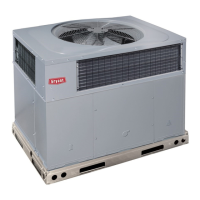
Do you have a question about the Bryant 577C--A and is the answer not in the manual?
| Brand | Bryant |
|---|---|
| Model | 577C--A |
| Category | Air Conditioner |
| Language | English |
Bryant's unique refrigerant designed to protect the environment. Puron is an HFC refrigerant without chlorine.
Factory-assembled, self-contained unit prewired, pre-piped, and pre-charged for minimum installation expense.
High-tech composite base with sloped drain pan; metal base rails for stability and handling.
Unit designed for downflow or horizontal applications, convertible in the field.
Explains the various codes and designations within the unit's model number.
Identifies the codes representing the nominal cooling capacity in tons.
Explains the codes for the nominal heating input capacity in Btuh.
Details factory options and variations indicated in the model number.
Table detailing nominal cooling capacity, CFM, EER, and SEER.
Table showing heating input, output capacity, temperature rise, and AFUE.
Table listing sound power levels across different octave bands.
Details nominal capacities, shipping weights, and refrigerant quantities.
Lists specifications for indoor and outdoor coils and fans.
Continues listing specifications for unit components and furnace sections.
Details motor specs, furnace section components, and safety switches.
Base unit with tin plated indoor coil hairpins option.
Provides additional starting torque for single-phase compressors.
Provides anti-floodback protection for low-load cooling.
Provides outdoor air for cooling and reduces compressor operation.
Details unit weight, center of gravity, and corner weights.
Specifies clearances to combustible materials and for operation/servicing.
Provides top, front, side, and rear views with dimension lines.
Details weight, center of gravity, and corner weights for larger units.
Specifies required clearances for operation and servicing for various unit sizes.
Shows top, front, side, and rear views with dimensions for larger units.
Illustrates the construction and components of a roof curb.
Provides dimensions for small/common and large curbs and unit placement guidance.
Steps 1-3: Identify cooling/heating requirements and select the unit.
Steps 4-5: Determine fan/power needs and match electrical characteristics.
Detailed tables of net capacity, sensible heat, kW, and efficiency ratings.
Detailed tables of net capacity, sensible heat, kW, and efficiency ratings.
Detailed tables of net capacity, sensible heat, kW, and efficiency ratings.
Detailed tables of net capacity, sensible heat, kW, and efficiency ratings.
Detailed tables of net capacity, sensible heat, kW, and efficiency ratings.
Detailed tables of net capacity, sensible heat, kW, and efficiency ratings.
Explains legends, notes, and formulas used in performance data.
Provides CFM data for horizontal/downflow discharge at different static pressures.
Provides CFM data for horizontal/downflow discharge at different static pressures.
Provides CFM data for horizontal/downflow discharge at different static pressures.
Provides CFM data for horizontal/downflow discharge at different static pressures.
Provides CFM data for horizontal/downflow discharge at different static pressures.
Details orifice sizes and manifold pressure for natural gas at different altitudes.
Details orifice sizes and manifold pressure for propane at different altitudes.
Explains how altitude affects heating input for propane and natural gas.
Illustrates typical roof mounting of the unit with ductwork.
Shows typical installation for a ground-level unit with gas and power connections.
Specifies condensate trap and ductwork connection requirements.
Details maximum/minimum airflow and ambient operating temperatures.
Lists voltage, compressor, motor FLA/LRA, MCA, and MOCP.
Explains how to calculate and the importance of voltage imbalance.
Illustrates connection and ladder logic for various electrical configurations.
Describes the sequence of operation for heating mode.
Describes the sequence of operation for cooling mode.
Explains the function of the Time Guard II for compressor protection.
General overview of the unit's system and design.
Lists required standards and certifications for the unit.
Specifications for cabinet construction, panels, base, and insulation.
Details fan specs and available optional features for the unit.
Covers NOx reduction, conversion kits, and time guard features.
